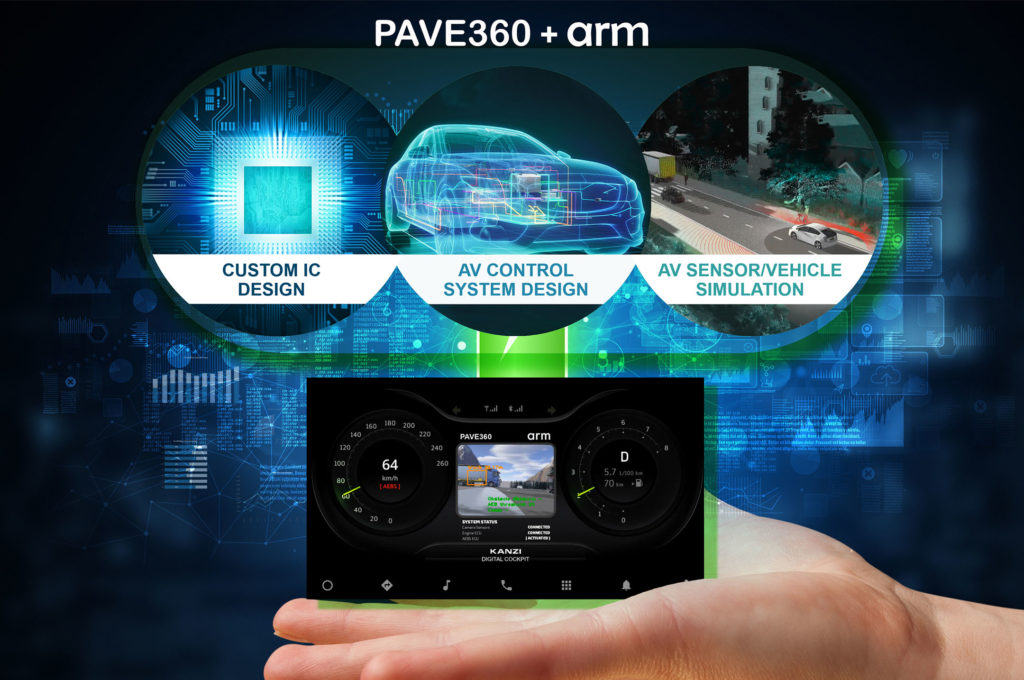Key Partnership Accelerates the Future of Mobility

Advanced integrated circuits (ICs) and system-on-chip (SoC) devices coupled with sophisticated software will be crucial enablers of future mobility technologies such as advanced driver assistance systems (ADAS), active safety, vehicle connectivity, and automated driving. Computing chips running sophisticated software already enable an immense amount of functionality in today’s vehicles. As vehicle automation progresses, silicon and software will combine to form the decision engine guiding autonomous vehicles through dense and dynamic driving environments. Between design and verification, the complexity of developing these advanced electronic systems is skyrocketing.
An autonomous vehicle is expected to produce several gigabits of data every second from the array of sensors and computing units distributed around the vehicle. As data is generated, the ICs and SoCs will need to process this data in near real-time to enable the vehicle to perceive, understand, and safely navigate its environment. Future automotive chips will be designed on the most advanced silicon technologies available to meet the power and performance requirements of service in an automated vehicle.
The software, chips, and other systems also have to be verified and validated for correct functionality and safety. Automated driving systems, whether full or only partially self-driving, must be tested and validated under billions of driving scenarios from the mundane to the extraordinary. What’s more, it is not enough to test the various sub-systems of a vehicle independently, especially for an autonomous vehicle. All systems, including the ICs and software, must be verified and validated in the context of the rest of the vehicle and its driving environments. Companies will need a verification solution that can cover all aspects of mobility, from chip to city.
As automotive companies prepare for the future of mobility, a new technology partnership has formed to support and accelerate the development of highly complex automotive electronic systems. Siemens has partnered with the global semiconductor IP leader Arm to bring cutting-edge IP, methodologies, processes and tools together to help automakers, integrators and suppliers collaborate, design and bring to market their next-generation platforms much faster (figure 1). The combination of Siemens’ solutions and Arm’s innovative semiconductor logic, cell, and processor IP can help automakers and suppliers deliver tomorrow’s electronic design and automotive solutions, today.

A key feature of this partnership is the combination of Siemens’ PAVE360 digital twin environment and Arm semiconductor IP. As part of the Siemens Xcelerator portfolio, PAVE 360 provides a high-fidelity virtual verification and validation environment that can model all parts of a vehicle, from sensors and ICs to vehicle dynamics and its driving environment. Integrating Arm IP allows the digital twin of the vehicle to run entire software stacks, generating early IC power and performance metrics under conditions accurate to the final vehicle.
Siemens’ PAVE360 and Arm IP enable automakers and suppliers to simulate and verify sub-system and SoC designs, and better understand how they perform within a vehicle design from the silicon level up, long before the vehicle is built. Furthermore, Arm’s automotive IP jump-starts the creation of safety-enabled silicon, bringing it within reach of the entire automotive supply chain.
Such capabilities will prove critical as the value of vehicles continues to shift towards electronics and software. Companies that own these critical vehicle components will extract the most value as the industry evolves. A virtual verification and validation environment leveraging a robust digital twin of the vehicle will enable companies to innovate and differentiate through custom designed electronics and software. In addition, the inclusion of leading semiconductor IP lowers the barriers to entry for companies throughout the supply chain and accelerates the development of next generation automotive electronic systems. The combination of these technologies will help companies bring new vehicle platforms and features to market faster and with greater confidence, setting the stage for success in the future of mobility and transportation.


